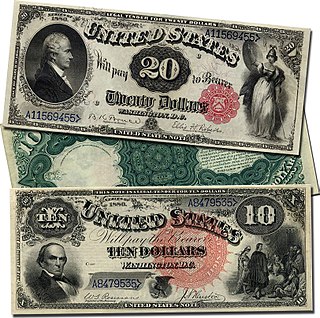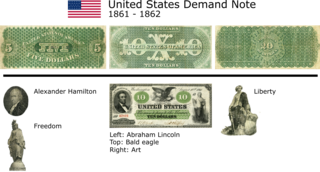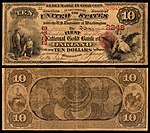
Federal Reserve Notes, also United States banknotes, are the currently issued banknotes of the United States dollar. The United States Bureau of Engraving and Printing produces the notes under the authority of the Federal Reserve Act of 1913 and issues them to the Federal Reserve Banks at the discretion of the Board of Governors of the Federal Reserve System. The Reserve Banks then circulate the notes to their member banks, at which point they become liabilities of the Reserve Banks and obligations of the United States.

A United States Note, also known as a Legal Tender Note, is a type of paper money that was issued from 1862 to 1971 in the U.S. Having been current for 109 years, they were issued for longer than any other form of U.S. paper money. They were known popularly as "greenbacks", a name inherited from the earlier greenbacks, the Demand Notes, that they replaced in 1862. Often termed Legal Tender Notes, they were named United States Notes by the First Legal Tender Act, which authorized them as a form of fiat currency. During the early 1860s the so-called second obligation on the reverse of the notes stated:
This Note is a Legal Tender for all debts public and private except Duties on Imports and Interest on the Public Debt; and is receivable in payment of all loans made to the United States.

Legal tender is a form of money that courts of law are required to recognize as satisfactory payment for any monetary debt. Each jurisdiction determines what is legal tender, but essentially it is anything which when offered ("tendered") in payment of a debt extinguishes the debt. There is no obligation on the creditor to accept the tendered payment, but the act of tendering the payment in legal tender discharges the debt.

The United States fifty-dollar bill ($50) is a denomination of United States currency. The 18th U.S. president (1869-1877), Ulysses S. Grant, is featured on the obverse, while the U.S. Capitol is featured on the reverse. All current-issue $50 bills are Federal Reserve Notes.

The United States one-hundred-dollar bill ($100) is a denomination of United States currency. The first United States Note with this value was issued in 1862 and the Federal Reserve Note version was launched in 1914, alongside other denominations. Statesman, inventor, diplomat, and American Founding Father Benjamin Franklin has been featured on the obverse of the bill since 1914. On the reverse of the banknote is an image of Independence Hall in Philadelphia, which has been used since 1928. The $100 bill is the largest denomination that has been printed and circulated since July 13, 1969, when the larger denominations of $500, $1,000, $5,000, and $10,000 were retired. As of December 2018, the average life of a $100 bill in circulation is 22.9 years before it is replaced due to wear.
Large denominations of United States currency greater than $100 were circulated by the United States Treasury until 1969. Since then, U.S. dollar banknotes have been issued in seven denominations: $1, $2, $5, $10, $20, $50, and $100.

Silver certificates are a type of representative money issued between 1878 and 1964 in the United States as part of its circulation of paper currency. They were produced in response to silver agitation by citizens who were angered by the Fourth Coinage Act, which had effectively placed the United States on a gold standard. The certificates were initially redeemable for their face value of silver dollar coins and later in raw silver bullion. Since 1968 they have been redeemable only in Federal Reserve Notes and are thus obsolete, but still valid legal tender at their face value and thus are still an accepted form of currency.

The pound was the currency of Australia from 1910 until 14 February 1966, when it was replaced by the Australian dollar. Like other £sd currencies, it was subdivided into 20 shillings, each of 12 pence.

Gold certificates were issued by the United States Treasury as a form of representative money from 1865 to 1933. While the United States observed a gold standard, the certificates offered a more convenient way to pay in gold than the use of coins. General public ownership of gold certificates was outlawed in 1933 and since then they have been available only to the Federal Reserve Banks, with book-entry certificates replacing the paper form.
The history of the United States dollar began with moves by the Founding Fathers of the United States of America to establish a national currency based on the Spanish silver dollar, which had been in use in the North American colonies of the Kingdom of Great Britain for over 100 years prior to the United States Declaration of Independence. The new Congress's Coinage Act of 1792 established the United States dollar as the country's standard unit of money, creating the United States Mint tasked with producing and circulating coinage. Initially defined under a bimetallic standard in terms of a fixed quantity of silver or gold, it formally adopted the gold standard in 1900, and finally eliminated all links to gold in 1971.

A Demand Note is a type of United States paper money that was issued from August 1861 to April 1862 during the American Civil War in denominations of 5, 10, and 20 US$. Demand Notes were the first issue of paper money by the United States that achieved wide circulation and they are still in circulation today, though they are now extremely rare. The U.S. government placed the Demand Notes into circulation by using them to pay expenses incurred during the Civil War including the salaries of its workers and military personnel.

The currencies of Puerto Rico closely follow the historic development of Puerto Rico. As a Province of Spain and a territory of the United States, Puerto Rico was granted the use of both foreign and provincial currencies. Following the Spanish colonization in 1502, Puerto Rico became an important port, with its own supply of gold. However, as the mineral reserves ran empty within the century, the archipelago's economy suffered. The Spanish Crown issued the Situado Mexicano, which meant that a semi-regular shipment of gold from the Viceroyalty of New Spain would be sent to the island, as a way to provide economic support. Between 1636 and 1637, Philip IV of Spain imposed a tax which had to be paid using a revenue stamp. Inspired by this, Puerto Rico began producing banknotes in 1766, becoming the first Overseas Province to print 8-real banknotes in the Spanish Empire and which in the Spanish government's approval of subsequent issues.

Fractional currency, also referred to as shinplasters, was introduced by the United States federal government following the outbreak of the Civil War. These low-denomination banknotes of the United States dollar were in use between 21 August 1862 and 15 February 1876, and issued in denominations of 3, 5, 10, 15, 25, and 50 cents across five issuing periods. The complete type set below is part of the National Numismatic Collection, housed at the National Museum of American History, part of the Smithsonian Institution.

Greenbacks were emergency paper currency issued by the United States during the American Civil War that were printed in green on the back. They were in two forms: Demand Notes, issued in 1861–1862, and United States Notes, issued in 1862–1865. A form of fiat money, the notes were legal tender for most purposes and carried varying promises of eventual payment in coin, but were not backed by existing gold or silver reserves.
Bills of credit are documents similar to banknotes issued by a government that represent a government's indebtedness to the holder. They are typically designed to circulate as currency or currency substitutes. Bills of credit are mentioned in Article One, Section 10, Clause One of the United States Constitution, where their issuance by state governments is prohibited.

The Treasury Note was a type of representative money issued by the United States government from 1890 until 1893 under authority of the Sherman Silver Purchase Act in denominations of $1, $2, $5, $10, $20, $50, $100 and $1,000. It was issued in two series: an 1890 series with $1, $2, $5, $10, $20, $100 and $1,000 denominations, and an 1891 series that added the $50 denomination. A $500 note was designed but never issued.
Banknotes of the United States dollar are currently issued as Federal Reserve Notes (1914–).
A silver certificate is a certificate of ownership that silver owners hold instead of storing the actual silver. Several countries have issued silver certificates, including Cuba, the Netherlands, and the United States. Silver certificates have also been privately issued by various mints and bullion companies. One example was the Liberty Dollar issued by NORFED from 1998 to 2009.

The United States two-dollar bill ($2) is a current denomination of United States currency. A portrait of Thomas Jefferson, the third president of the United States (1801–1809), is featured on the obverse of the note. The reverse features an engraving of the circa 1818 painting Declaration of Independence by John Trumbull.
The 2 yen note (2円券) was a denomination of Japanese yen issued in two different overlapping series from 1872 to 1880 for use in commerce. Meiji Tsūhō "two yen" notes were the first to be released as inconvertible government notes in 1872. These notes were produced both domestically, and in Germany using western technology. While they had an elaborate design, the notes eventually suffered in paper quality, and were counterfeited. Two yen Meiji Tsūhō notes were not redesigned with other denominations in response to these issues. The series as a whole was effected by massive inflation that occurred during the aftermath of the Satsuma Rebellion in 1877. Too many non convertible notes had been issued to pay for the expenses incurred. Government notes stopped being issued in 1879, and the Bank of Japan was established in 1882 as a way to redeem old notes for new ones issued by the bank. This redemption period expired when the notes were abolished on December 9, 1899.




















